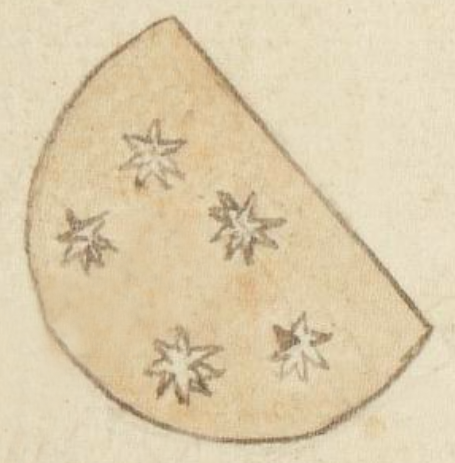ilhuicatl (Azca24)
This painted black-line drawing of the sky (ilhuicatl) with stars is an element in the compound glyph for Motecuhzoma Ilhuicamina. The sky is a tan color, and the stars are white. The sky and stars fill a half circle. In the original glyph, an arrow pierces the sky. We have digitally removed the arrow, reconstructing the space where it had appeared. If it had not been for the arrow, perhaps another star would have filled that space. At any rate, there are five seven-to-eight pointed stars.
Stephanie Wood
We have no gloss for this element, as the compound from which it came was not glossed. Still, it is similar enough in content and appearance, that we feel certain of the analysis. Stars can come in the shape of eyes and simple white circular objects, or they can have points much like the stars in European art. Skies can be a rectangular band, as seen in the Codex Mendoza, or circular. Some are entirely round, some are half circles, or a filled U-shape. See examples below.
Stephanie Wood
post-1550, possibly from the early seventeenth century.
Jeff Haskett-Wood
cielos, estrellas, celeste

ilhuica(tl), sky, heavens, celestial realm, https://nahuatl.wired-humanities.org/content/ilhuicatl
cielo
Stephanie Wood
The Codex Azcatitlan is also known as the Histoire mexicaine, [Manuscrit] Mexicain 59–64. It is housed in the Bibliothèque Nationale de France, and hosted on line by the World Digital Library and the Library of Congress, which is “unaware of any copyright or other restrictions in the World Digital Library Collection.”
https://www.loc.gov/resource/gdcwdl.wdl_15280/?sp=24&st=image
The Library of Congress is “unaware of any copyright or other restrictions in the World Digital Library Collection.” But please cite Bibliothèque Nationale de France and this Visual Lexicon of Aztec Hieroglyphs.



